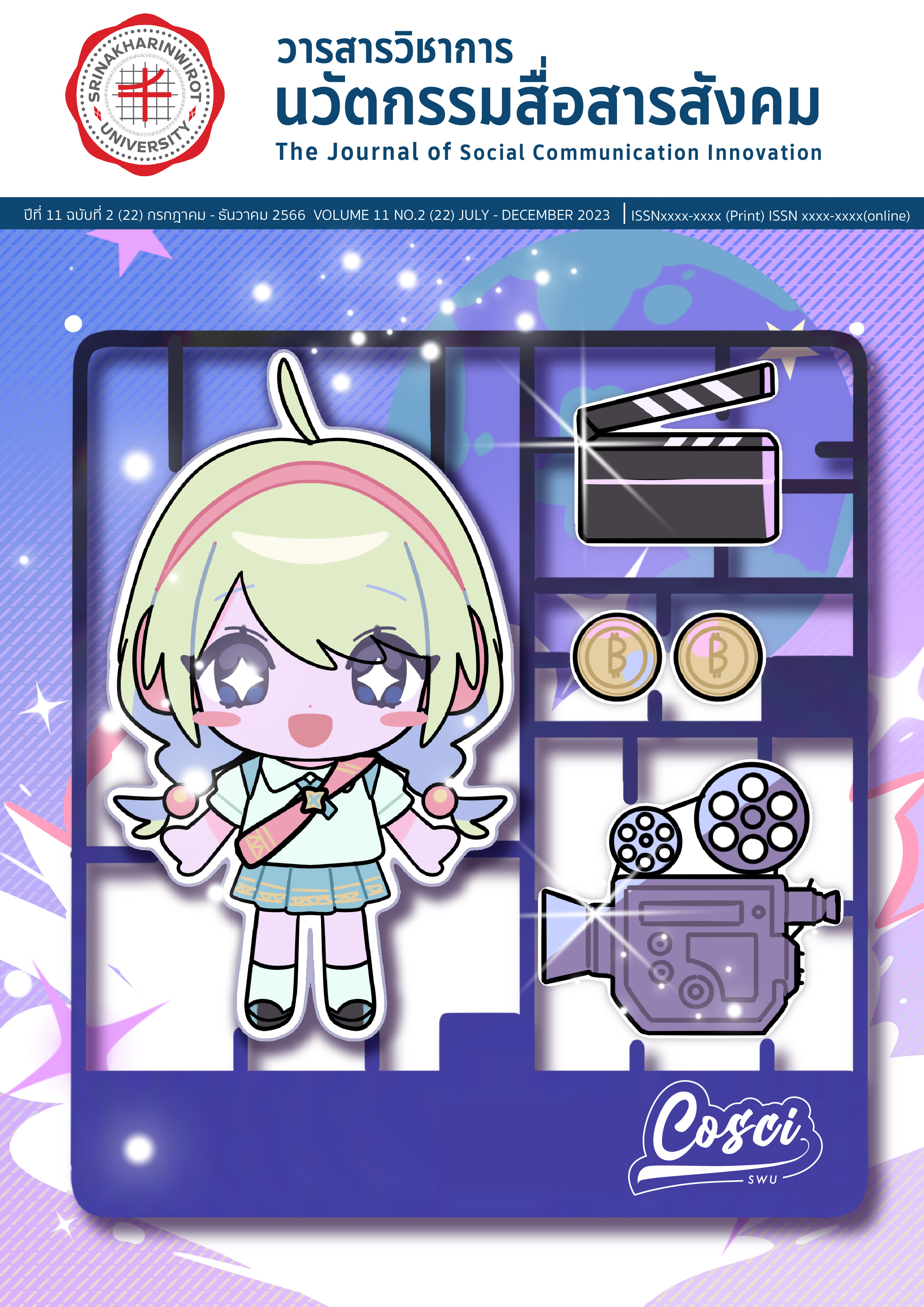การสร้าง Micro-influencer จากกรณีศึกษาของยูทูเบอร์ในประเทศไทย
คำสำคัญ:
ต้นทุนทางวัฒนธรรม, พฤติกรรมผู้บริโภค, ผู้มีอิทธิพลบทคัดย่อ
ประเทศไทยขึ้นชื่อเรื่องการให้ความสนใจต่อคนดังเป็นอย่างมาก แต่ด้วยการเพิ่มขึ้นของโซเชียลมีเดีย ภูมิทัศน์ของสื่อจึงเปลี่ยนไป ในปัจจุบันผู้คนสามารถได้รับอิทธิพลจากบุคคลธรรมดาทั่วไปที่เรียกว่า Micro-influencer มากกว่าผู้มีชื่อเสียงแบบดั้งเดิม งานวิจัยนี้ศึกษาการเปลี่ยนผ่านที่บุคคลธรรมดาสามารถกลายเป็น Micro-influencer ได้ในภูมิทัศน์สื่อที่เปลี่ยนแปลงไปของประเทศไทย จากการศึกษา 24 กรณีศึกษาของยูทูเบอร์ชาวไทยที่มีผู้ติดตาม 10,000 ถึง 100,000 คน ผู้วิจัยสำรวจว่า Micro-influencer เหล่านี้มีปฏิสัมพันธ์และมีอิทธิพลต่อผู้ติดตามของพวกเขาอย่างไร การศึกษานี้ใช้ทฤษฎีของต้นทุนทางวัฒนธรรมของ Bourdieu (1984) และพฤติกรรมผู้บริโภคของ Holt (1995) นักวิจัยได้สังเกตการณ์ช่องของยูทูเบอร์ และพฤติกรรมการบริโภคของทั้งตัวผู้มีอิทธิพลและผู้ติดตามผ่านระเบียบวิจัยที่เรียกว่า Netnography หรือ ชาติพันธุ์วรรณนาทางอินเทอร์เน็ต งานวิจัยได้ค้นพบปัจจัยด้านความเกี่ยวข้อง (Relevancy) กิจวัตร (Ritual) การแทนที่ไม่ได้ (Irreplaceability) และความสัมพันธ์ (Relatability) โดยนำเสนอมุมมองใหม่เกี่ยวกับผู้มีอิทธิพลที่นอกเหนือไปจากการใช้ความงามทางกายภาพ และเน้นย้ำถึงความสำคัญของต้นทุนทางวัฒนธรรมสำหรับผู้มีอิทธิพลในการสร้างผลกระทบที่มีความหมายต่อชีวิตของผู้ติดตาม ท้ายที่สุดแล้ว การศึกษานี้มีเป้าหมายเพื่อให้ข้อมูลเชิงลึกสำหรับองค์กรสื่อในประเทศไทยให้เติบโตในยุคดิจิทัล
เอกสารอ้างอิง
Belk, R. W. (1988). Possessions and the Extended Self. Journal of Consumer Research. 15(2), 139-168.
Berryman, R., & Kavka, M. (2017). ‘I Guess A Lot of People See Me as a Big Sister or a Friend’: the role of intimacy in the celebrification of beauty vloggers. Journal of Gender Studies 26(3), 307-320.
Berthon, PR., Pitt, L. McCarthy, I., & Kates, S. (2007). When Customers Get Clever: Managerial Approaches to Dealing with Creative Consumers. Business Horizons. 50(1), 39-47.
Bourdieu, P. (1984). Distinction: A Social Critique of the Judgement of Taste. Cambridge.MA: Harvard University Press.
Braun, V., & Clarke, V. (2006). Using thematic Analysis in Psychology. Qualitative Research in Psychology. 3(2), 77-101.
Braun, V., & Clarke, V. (2013). Successful qualitative research: A practical guide for beginners. London, UK: SAGE.
Bruhn, M., Schoenmueller, V., & Schäfer, D.B. (2012). Are social media replacing traditional media in terms of brand equity creation?. Management Research Review. 35(9), 770-790.
Champniss, G., Wilson, H., & Mcdonald, E.K. (2015). Why Your Customers' Social Identities Matter The way consumers see themselves determines their behavior-and you can influence that. Harvard Business Review. 93(1-2), 88-96.
Chapple, C., & Cownie, F. (2017). An investigation into viewers’ trust in and response towards disclosed paid-for-endorsements by YouTube lifestyle vloggers. Journal of Promotional Communications. 5(2), 110–136.
Cheung, M. L., Leung, W. K. S., Aw, E. C.- X., & Koay, K. Y. (2022). “I follow what you post!”: The role of social media influencers’ content characteristics in consumers’ online brand-related activities (COBRAs). Journal of Retailing and Consumer Services. 66, 102940.
Couldry, N. (2004). Teaching us to fake it: The ritualized norms of television’s “reality” games. In S. Murray & L. Ouellette (Eds.). Reality TV: Remaking television culture. 57–74. New York, NY: New York University Press.
Datareportal. (2023). DIGITAL 2023: THAILAND. Retrieved March 1, 2023. from https://datareportal.com/reports/digital-2023-thailand
De Certeau, M. (1984). The Practice of Everyday Life. Berkeley: University of California Press.
De Mooji, M. (2014). Global Marketing and Advertising, Understanding Cultral Paradoxes. 4th ed.. Sage. Los Angeles. CA.
Digital Business Lab (2022). Social Media Penetration in Thailand. Retrieved March 1, 2023. from https://digital-business-lab.com/2022/07/②-social-media-penetration-in-thailand-research/
Duffy, B.E. (2010). Empowerment through endorsement? Polysemic meaning in Dove’s user generated advertising. Communication. Culture & Critique. 3, 26–43.
Guest, G., Bunce, A., & Johnson, L. (2006). How Many Interviews Are Enough?. Field Methods. 18(1), 59-82.
Holt, D. B. (1995). How Consumers Consume: A Typology of Consumption Practices. Journal of Consumer Research. 22(1), 1-16.
Holt, D. B. (1998). Does Cultural Capital Structure American Consumption?. Journal of Consumer Research. 25(1), 1-25.
Kozinets, R.V. (1998). On Netnography: Initial Reflections on Consumer Research Investigations of Cyberculture. Advances in Consumer Research. 25, 366–371.
Kutthakaphan, R., & Chokesamritpol, W. (2013). The use of Celebrity Endorsement with the help of electronic communication channel Instagram. Thesis. Malardalen University School of Business. Society and Engineering.
Liu, J. C. et al. (2015). Identifying effective influencers based on trust for electronic word-of-mouth marketing: A domain-aware approach. Information Sciences. 306, 34-52.
Marwick, A. E. (2013). Status update: Celebrity, publicity and branding in the social media age. New Haven. CT: Yale University Press.
Marwick, A. E., & Boyd, d. (2011). To see and be seen: Celebrity practice on Twitter. Convergence. 17(2), 139–158.
Nafees, L., Stoddard, J. E., Cook, C., & Nikolov, A. N. (2021). Can social media influencer (SMI) power influence consumer brand attitudes? The mediating role of perceived SMI credibility. Digital Business. 1(2), 100008
Nouri, M. (2018). The Power of Influence: Traditional Celebrity vs Social Media Influencer. Advanced Writing: Pop Culture Intersections. 32.
Potavanich, T. (2019). The concept of Micro-celebrity and its phenomenon in Thailand. The Journal of Social Communication Innovation. 7(2), 244-253.
Ruiz-Gomez, A. (2019). Digital Fame and Fortune in the age of Social Media: A Classification of social media influencers. aDResearch ESIC. 19(19), 8-29.
Schiffman L.G, Hansen H., & Kanuk, L. (2012). Consumer behaviour. Financial Times.
Schivinski, B., Brzozowska-Woś, M., Stansburry, E., & Satel, J. (2020). Exploring the Role of Social Media Use Motives, Psychological Well-Being, Self-Esteem, and Affect in Problematic Social Media Use. Frontiers in Psychology. 11, 617140.
Schivinski, B., Christodoulides, G., & Dabrowski, D. (2016). Measuring consumers' engagement with brand-related social-media content. Journal of Advertising Research 56, 64–80.
Schouten, A.P., Janssen, L. & Verspaget, M. (2020). Celebrity vs. influencer endorsements in advertising: the role of identification, credibility, and product-endorser fit. International Journal of Advertising. 39(2), 258–281.
Senft, T. (2013). Microcelebrity and the Branded Self, Companion to New Media Dynamics. 346–54. Malden, MA: Blackwell.
Shao, G. (2009). Understanding the Appeal of User-Generated Media: A Uses and Gratification Perspective. Internet Research. 19(1), 7–25.
Tesseras, L. (2018). A third of brands admit to not disclosing influencer partnerships. Retrieved March 1, 2023. from https://www.marketingweek.com/influencer-marketing-partnerships/
Thai Examiner (2019). Thailand’s advertisers power the shift to online media in 2019 as print loses out to the internet. Retrieved March 1, 2023. from https://www.thaiexaminer.com/thai-news-foreigners/2019/02/18/advertising-thailand-media-thai-social-media-online-broadcast-tv-brands/
The Nation (2015). Is celebrity influence still a force to be reckoned with in the social media age?. Retrieved March 1, 2023. from http://www.nationmultimedia.com/business/Is-celebrity-influence-still-a-force-to-be-reckone-30251918.html
Tiwsakul, R.l., & Hackley, C. (2006). Young Thai and Uk Consumers' Experiences of Television Product Placement- Engagement, Resistance and Objectification. Asia-Pacific Advances in Consumer Research. 7, 372-377.
Trigg, A. B. (2001). Veblen, Bourdieu, and Conspicuous Consumption. Journal of Economic Issues. 35(1), 99-115.
Valck, K. d.-T. (2013). Social Commerce: A Contingency Framework for Assessing Marketing Potential. Journal of Interactive Marketing. 27, 311-323.
Wells, D. (2018). INFLUENCERS RULE IN THAILAND. Retrieved March 1, 2023. from https://vero-asean.com/influencers-thailand/
Yuwakosol and Chompukum (2021). Opinion and Media Usage Among Generations in the Digital Age. The Journal of Social Communication Innovation. 2(18), 10-25.
ดาวน์โหลด
เผยแพร่แล้ว
รูปแบบการอ้างอิง
ฉบับ
ประเภทบทความ
สัญญาอนุญาต
ลิขสิทธิ์ (c) 2023 วารสารวิชาการนวัตกรรมสื่อสารสังคม

อนุญาตภายใต้เงื่อนไข Creative Commons Attribution-NonCommercial-NoDerivatives 4.0 International License.
บทความทุกบทความที่ได้รับการตีพิมพ์ถือเป็นลิขสิทธิ์ของวารสารวิชาการนวัตกรรมสื่อสารสังคม มหาวิทยาลัยศรีนครินทรวิโรฒ







